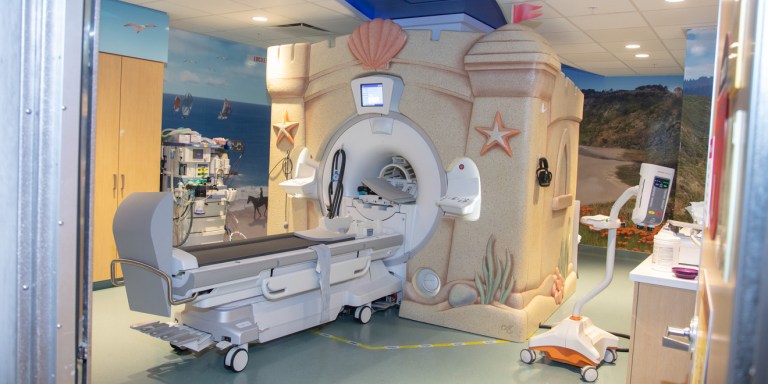The Lucile Packard Children’s Hospital’s new Main building— equipped with a range of new tools, including a cutting-edge clinical scanner— has brought about significant improvements to the hospital experience for patients, their families and staff, since its Dec. 9 opening, doctors report.
Housed in the building’s new imaging center, the new scanner simultaneously conducts Positron Emission Tomography (PET) and Magnetic Resonance Imaging (MRI) tests.
Formerly, patients relied on separate systems for MRI and Computed Tomography (CT) scans and used separate systems housed in the hospital’s West building. PET scans also were unavailable in the West building because of space restrictions.
The imaging center’s PET-MRI scanner has improved both the patient scanning experience and interpretable results, according to Dr. Shreyas Vasanawala M.D./Ph.D. ’01, Lucile Packard Children’s Hospital’s MRI Director and a professor of radiology at the medical school.
Dr. Vasanawala said that the new PET-MRI scanner performs both types of scans simultaneously, allowing doctors to better understand the tissue scanned.
“With the MRI and PET images together, we can then actually interpret [the images] together,” he said.
The new system also brings increased patient comfort and shortened hospital stays. Previously, if a patient needed both types of scans, doctors would have to put them under a different anesthesia each time. These tests would also occur on separate days.
“But now, you can put them under anesthesia once,” he said.
Further, the majority of patients treated are children, who, according to Vasanawala, have a hard time staying still long enough for clear scans.
In addition, the center has new interior decorations that serve as distractions for child patients. The decorations help to calm the children undergoing imaging procedures who would otherwise tend to move around and influence scan accuracy.
It’s common practice to give child patients anesthesia to prevent undue movements.
“What we are hearing from our care teams is that thanks to the distraction techniques… more [child] patients are able to go [under the scans] without anesthesia,” said Samantha Beal, the hospital’s director of media and public relations.
According to Jill Sullivan, vice president of hospital transformation, these changes have improved the patient experience.
”There has been a lot of positive feedback [on the new imaging center],” she said.
Further, the addition of 149 new hospital beds have transformed patient and family experience in the hospital. According to Sullivan, each patient is offered a private room complete with a private bathroom and a place for up to two family members to sleep.
“This [ability to sleep with their children] was something [the parents] had asked us for,” said Sullivan.
In addition, the new rooms have larger TVs, a gaming system and lighting control board to keep child patients entertained during their stay. Since patients sometimes do not leave their rooms during their stay, each room features an outdoor flower box to provide fresh reminders of nature.
The new building also contains an additional cafe and gardens that both the patients’ families and staff enjoy.
While the new building has been open for six months already, not all of its units are in operation. Dr. Vasanawala said that the hospital is still preparing to unveil its new surgical unit, the Bonnie Uytengsu and Family Surgery and Intervention Center, on Jun. 30. Within this unit, there will be a MRI scanner for use during surgical operations that employs more powerful magnetic field gradients to increase scanning speed.
In the coming months, the facility’s Imaging Center will also get a magnetic resonance (MR) guided Focused Ultrasound, which conducts non-invasive surgery by concentrating soundwaves to a millimeter point. The new MRI scanner is used to guide and control the treatment. Just like with the PET-MRI, Dr. Vasanawala expects this new equipment to provide improved treatment experiences at the hospital.
Contact Christina Pan at capan ‘at’ stanford.edu.
A previous version of this article incorrectly stated that Vasavawala is the MRI Director for Stanford Hospital rather that the Children’s Hospital. This post has also been updated to clarify several points: the effects of the new PET-MRI scanner, the role of anesthesia for child patients, rooms’ accommodations for family members and details of the new MRI scanner and MR-guided Focused Ultrasound.
